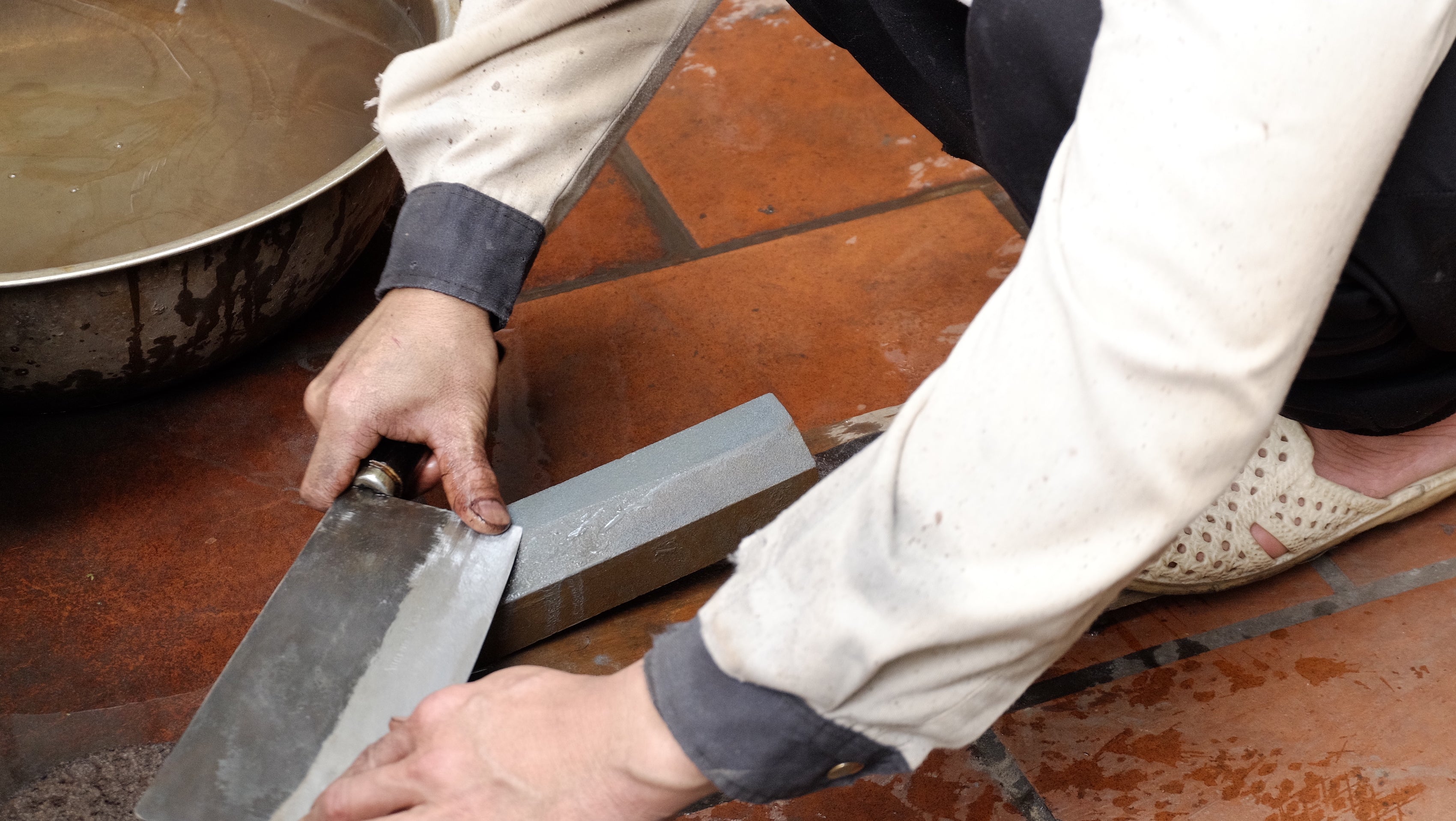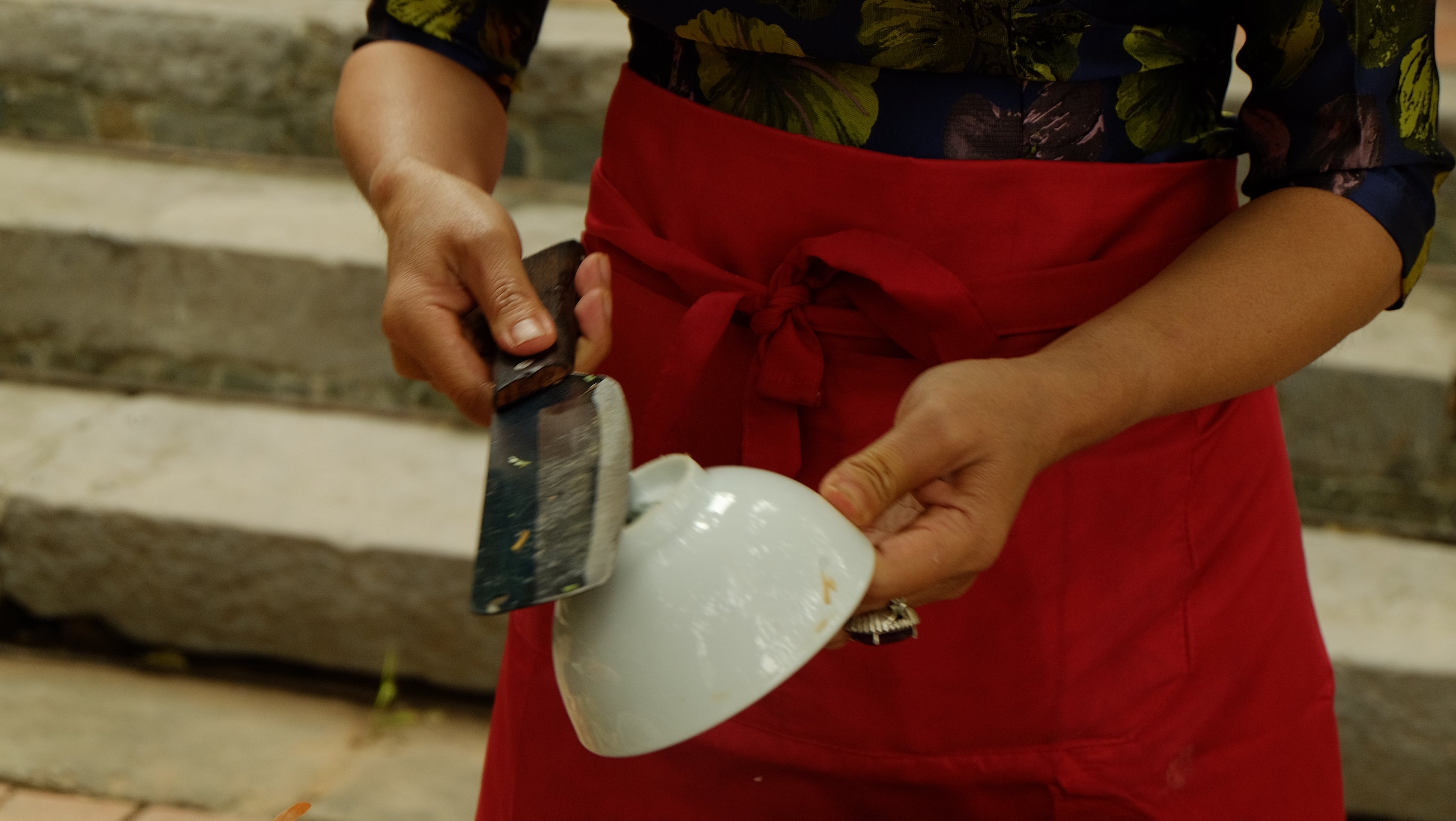
Care for your knives
AUTHENTIC BLADES care & sharpening
_
Because cutting doesn't just involve knives
Our knives and scissors are made from high carbon steel which is extremely sharp and hold its edge and easy to resharpen. To keep it that way, you have to maintain it. For the best care, optimal protection and a particularly sharp blade for your AUTHENTIC BLADES, we offer you the right instructions and are working on also providing the right accesoires.
Collapsible content
BASIC CARE
Marks of Character and CraftsmanshipWhen you first see marks on your new, carefully selected knife, it might be surprising. However, these marks are not flaws but rather signs of the unique journey your knife will take with you.
REMOVE RESINOUS LAYER & GREASY OIL
If your knife or your AUTHENTIC BLADES scissors are a little greasy or a resinous layer has formed on the blade, you can clean them with a little dishwashing liquid and a damp cloth. Care or baby wipes are also well suited – as long as they do not contain acid.
Note: The resinous layer is not rust, but a natural discoloration caused by the erosion of the carbon steel. These discolorations can also be easily removed with a Japanese polishing rubber.
CARE OF THE AUTHENTIC BLADES WOODEN HANDLE
Our wooden handles are handcrafted from simple white cedar timber and fire roasted. This gives the rapidly growing wood its typical dark color. They might rub off a bit at the beginning. However, after only a short time this won’t happen anymore. Note that the wood reacts sensitively to low humidity. To prevent it from becoming porous, you should rub the handle with a little vegetable oil from time to time. If your blade becomes unstable and begins to wobble, you can simply place the handle in a glass of water to swell. Simply let it sit in the filled jar for a few hours until the handle is firm again.
CLEANING THE BLADE
The blades of our knives are made from high carbon steel. Therefore, you should protect them from constant moisture, do not clean them in the dishwasher, clean them with a damp cloth after use and dry them immediately. Some people find that washing them in the sink with your everyday sponge incl some dishwashing soap is fine. If you use the knife to cut acidic foods such as citrus fruits or onions, you should definitely clean them with a little detergent afterwards. To ensure that the blade is well protected, you can also oil it from time to time.
SHARPENING THE BLADE
To ensure that your AUTHENTIC BLADES stay really sharp, you can sharpen them yourself if necessary. Ideally with a natural whetstone. In addition to whetstones, sharpening rods, ideally ceramic, are also suitable for sharpening your knives and scissors. In an astonishingly short time and with just a few grinding movements, you can restore the original sharpness of your blades. Over in Vietnam we even see people using the bottom of unglazed ceramics. As we said, this type of steel is very easy to sharpen compared to stainless steel.

Excited about our knives and our standards? Become a dealer for AUTHENTIC BLADES.
FAQs
Embracing the Beauty of Your New Knife
Marks of Character and CraftsmanshipWhen you first see marks on your new, carefully selected knife, it might be surprising. However, these marks are not flaws but rather signs of the unique journey your knife will take with you.
Understanding the Marks
One of the most frequent questions from new knife owners concerns the dark marks that appear on high carbon steel blades. These marks are a natural part of the knife’s character and cannot be washed away. Instead, they evolve into a beautiful patina that lasts a lifetime and adds to the blade’s story.
What is a Patina?
A patina is the beautiful discoloration that forms on steel lacking stainless elements like chromium. It can show up in shades of yellow, blue, and grey, giving your knife a unique, aged look. Different steels develop patinas in various colors, much like how copper and bronze age into stunning greens and blues. While these steel types can also develop rust spots if not kept dry, a patina can act as a protective layer against rust.
Identifying Patina vs. Rust
Learning to distinguish between patina and rust is essential. Patina is a uniform discoloration that enhances the blade’s aesthetic and provides a layer of protection. It typically appears in shades of blue, grey, and yellow. Rust, on the other hand, appears as reddish-brown spots and tends to form unevenly. Surface rust is not immediately harmful to your knife, but if left unchecked for a long time, it can eventually erode the steel.
Causes of Patina Formation
From the first use, your blade starts to develop a patina due to exposure to moisture, acids, and salts. The acidity of citrus and the moisture from proteins create different markings on the blade. Even touching the knife with bare hands can leave behind fingerprints that lead to patina or rust spots if not wiped away promptly.
The Benefits of a Patina
Once a patina forms, it acts like a seal, protecting the steel underneath from rust. Your knife may not look brand new, but it becomes uniquely yours, bearing the marks of countless meals prepared with care.
Why Not Stainless Steel?
While stainless steel blades are easier to maintain and don’t discolor or rust as easily, they often lack the hardness and sharpness of high-carbon steel knives. A high-carbon steel Japanese chef knife can achieve a higher hardness (HRC) and maintain a sharp edge much longer. For chefs who use their knives daily, the trade-off of wiping down the blade between uses is worth the sharper, longer-lasting edge.
There are, however, exotic steel types like SG2/R2 and ZDP-189 that combine the benefits of high-carbon steel with high stainless elements, offering incredible performance and minimal maintenance. These knives are crafted by skilled artisans and are highly prized for their exceptional quality.
Removing a Patina
If you wish to remove the patina, you can use a knife polishing compound or a whetstone to carefully remove some steel from the affected area. This requires some skill and practice. However, keep in mind that a new patina will likely form with continued use.
Controlling Rust
To prevent rust spots, always wipe your knife with a clean cloth after use, keep it dry, and store it away from moisture and salt. While a patina is a natural and inevitable part of owning a high-carbon steel knife, it can protect your blade with proper care and maintenance, ensuring its longevity and continued performance.
Is Rust Harmful?
Rust is essentially iron oxide, a compound that comes from the earth. While consuming a small amount of surface rust won’t harm you, it may not taste pleasant. It’s best to remove rust from your knife to ensure your culinary creations are at their finest.
Addressing Surface Rust
Early surface rust is not harmful to your knife and can be removed with proper care. However, if rust is left on the blade for an extended period, it can eventually erode the steel. Regular maintenance and prompt attention to any signs of rust will keep your knife in excellent condition.
How to Remove Surface Rust
To remove surface rust from your knife, you can use:
Baking Soda Paste
- Mix baking soda with water to form a thick paste
- Apply the paste to the rusted area
- Use a soft cloth or brush to scrub the rust gently
- Rinse the knife with warm water and dry thoroughly
White Vinegar
- Soak a cloth in white vinegar
- Rub the rusted area with the vinegar-soaked cloth
- Rinse the knife with warm water and dry thoroughly
Rust Erasers
- Gently rub the rusted area with a rust eraser
- Wipe the knife with a clean cloth to remove any residue
- Rinse and dry the knife thoroughly
How to Remove Long-Term Rust
For more severe, long-term rust, follow these steps
Sandpaper or Steel Wool
- Use fine-grit sandpaper or steel wool to gently sand the rusted area
- Be careful not to scratch the blade excessively
- Wipe away any rust particles with a clean cloth
Knife Polishing Compound
- Apply a knife polishing compound to a soft cloth
- Rub the rusted area in a circular motion until the rust is removed
- Rinse the knife with warm water and dry thoroughly
Whetstone
- Use a whetstone to remove the rust by sharpening the blade
- Follow proper sharpening techniques to ensure even removal
- Rinse and dry the knife thoroughly
For Those Who Cherish Culinary Arts and Handcrafted Excellence
For those who love to cook, your knife isn’t just a tool—it’s a trusted companion in your culinary adventures. Each patina mark tells a story of the meals you’ve prepared, the love you’ve poured into your dishes, and the respect you have for traditional craftsmanship.
If you cherish the art of cooking and the beauty of handcrafted tools, you understand that a high-carbon steel knife is more than just a blade. It’s a piece of heritage, a testament to skilled artisans who respect the natural world and create with purpose and passion.
So, embrace the relationship with your knife. Nurture it, care for it, and let it become a part of your culinary journey. With a bit of humor, think of your knife as a culinary companion that’s a bit like you—capable of transformation, resilient, and always ready for the next delicious adventure.
